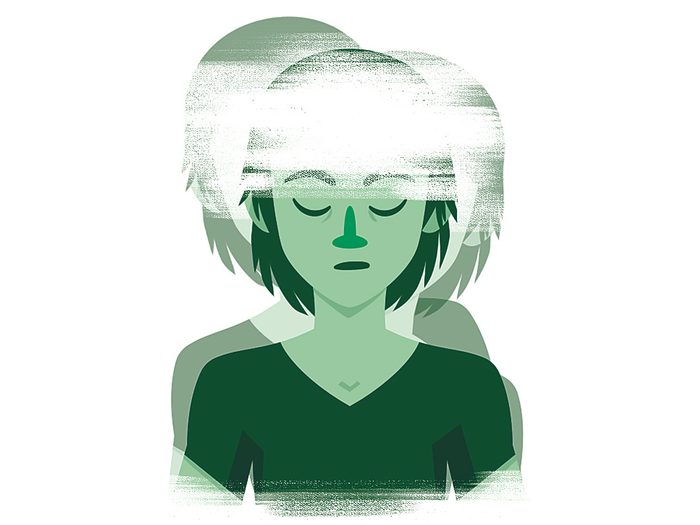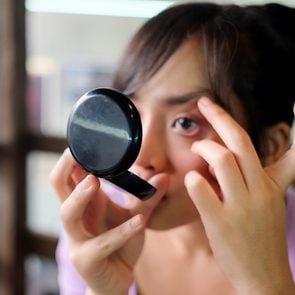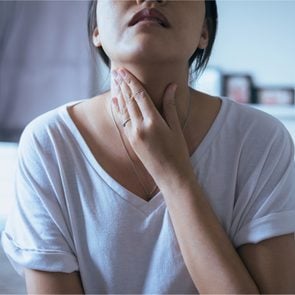For 20 Years, This Woman’s Mysterious Fainting Spells Stumped Doctors

Finally, Kim Ryberg turned to Google, where she found others suffering from the same strange symptoms. “Once I read about it, I started to cry,” she says...
The first time Kim Ryberg fainted, she was 13 years old. It was the early 2000s and she was in front of her classroom in rural Montana, delivering a presentation to her peers. She suddenly felt light-headed, then collapsed. When she woke up several minutes later, she went to the school nurse, who wasn’t sure why it had happened. Perhaps it was just nerves, she said. Ryberg went home for the day and hoped it wouldn’t happen again.
She wasn’t so lucky. Throughout high school, Ryberg fainted once or twice a month—in class, during choir recitals, at the grocery store. “It was like Russian roulette,” she says. Every morning she would wonder, “Am I going to faint today?”
Worse, Ryberg started experiencing other alarming symptoms: a racing heartbeat, vomiting and bouts of brain fog that made it hard to concentrate. One moment, she’d be sweating profusely; the next, she was freezing cold.
At first, Ryberg’s parents wondered whether she was just being dramatic, but when the issues continued, they took her to their family doctor. The GP was stumped—she’d never seen anything like it. Ryberg’s parents consulted more physicians, who diagnosed her as stressed or suffering from anxiety. Some said she was faking it to get attention. “Look at me and you’d think I was the healthiest person on planet earth,” she says. “That was part of the problem. I didn’t look sick.”
Living With an Unnamed Illness
Nonetheless, Ryberg’s mysterious illness shaped her life. She frequently missed school because of health problems and medical appointments. She chose not to drive—what if she fainted behind the wheel? “As if high school isn’t hard enough for the average person, I had all of this going on,” she says.
In her 20s, Ryberg moved to Los Angeles to pursue a career as a singer-songwriter. There she met her future husband, Or, a level-headed partner who lovingly helped Ryberg manage her symptoms. Meanwhile, she saw more than a hundred doctors, nurses, naturopaths and other medical professionals in her search for an answer. While some specialists tried to treat particular symptoms, no one could explain them all.
In her late 20s, Ryberg was no longer eligible for affordable health insurance in the U.S. For four years, she stopped seeing doctors entirely and began exercising regularly, hoping to improve her health on her own. Instead, her condition worsened. Simply sitting up could make her light-headed, and she vomited every week or two. Starting in October 2017, she was bedridden for roughly 18 months, relying on her husband and parents to feed, clothe and wash her.
As her condition deteriorated, Ryberg’s friends and family urged her to seek medical help again. But instead of going to a doctor, she went to Google. She’d searched her combination of ailments before but had never found any breakthroughs. This time, however, her online sleuthing led her to Facebook groups where people reported experiencing symptoms similar to hers. If it was indeed what she had, there was a name for it: postural orthostatic tachycardia syndrome, or POTS.
POTS Symptoms
POTS is a blood-circulation disorder. Those who have it experience irregular blood pressure and an abnormal heart rate, which means their blood doesn’t circulate properly, particularly when they make sudden movements or stay sedentary for prolonged periods. As a result, they sometimes faint when they try to stand up. Ryberg happened to fit the most common profile of a POTS patient: a white woman between 13 and 50. “Once I read about it, I started to cry,” she says. She felt she’d finally figured it out.
Ryberg’s research also revealed a specialist who could help her: Dr. Peng-Sheng Chen, a cardiologist at nearby Cedars-Sinai Medical Center in Los Angeles. Ryberg was able to book an appointment with him in October 2020. From the moment she arrived, Chen reassured Ryberg that her illness was real. “Just to have that validation was incredible,” she says.
For Chen, Ryberg’s situation was all too familiar. Though as many as 700,000 Americans have POTS, it is not well known among physicians. As one of the few doctors who focuses on the condition, Chen frequently sees people who have gone years without a correct diagnosis. Like Ryberg, many of them suffered from several broad symptoms that no one specialist was equipped to diagnose or treat.
Causes of POTS
While its ultimate cause is unknown, POTS may occur in patients after they suffer other illnesses, injuries or infections. Chen helped Ryberg discover that hers was linked to a genetic illness called mast cell activation syndrome, or MCAS, which is common among POTS patients. Everyone has mast cells; they produce a chemical called histamine, which helps our bodies fight allergens and, in the process, causes reactions like a runny nose and itchy eyes. But people with MCAS produce more histamine than normal, which creates problems all over the body.
Chen says it’s possible to detect these genetic abnormalities when patients are young, provided a doctor knows to look for them. In some cases, however, people go decades without answers, continuing to experience symptoms and risking anaphylactic shocks that can be fatal.
POTS Treament
Though neither POTS nor MCAS is curable, both are relatively easy to manage. Chen prescribed Ryberg an anti-inflammatory enzyme for her digestive issues, as well as an antihistamine. He also recommended that Ryberg wear compression clothing to keep blood flowing to her head, exercise lying down, and stay hydrated with electrolytes and salt pills.
When Ryberg began observing that regimen, her symptoms got better almost instantly. She still has occasional flare-ups, but her health has dramatically improved; she hardly ever faints anymore. She’s now back on her feet and dreams of starting a family—something that seemed impossible before she started following Chen’s medical advice. “Managing this type of condition comes down to your own willpower and wanting to get better,” she says. “Now that I know what healthy feels like, I will do literally anything to stay that way.”
Next, read the incredible story of how one woman’s x-ray revealed the source of her lifetime of stomach pain.






